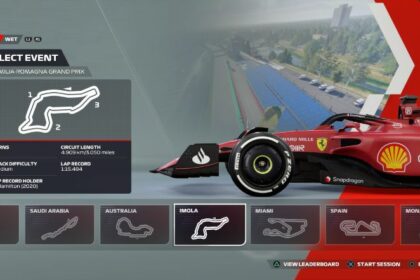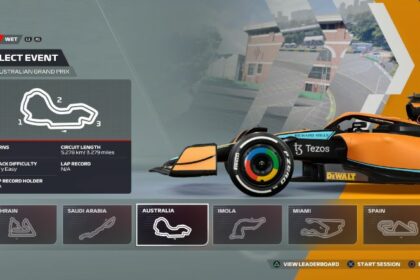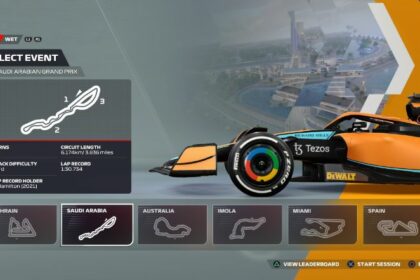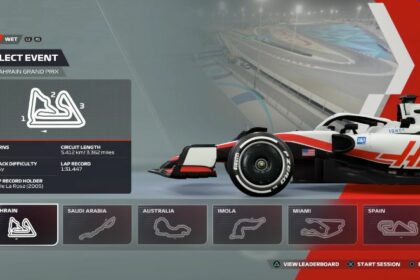Formula 1 is a sport of margins and milliseconds. It is about maximizing what you have in order to extract the most out of your car.
This is especially true when your cars are nearly identical to each other and the only things that separate you and your opponents are your skills behind the wheel and the setup of your car.
In this F1 22 setup guide, we will be looking at the best tuning setups for F1 22 and how to get to these setups by looking at the various settings you can tinker with in the setups screen and how these affect the cars in order to push the limit of your car.
Preset Setups
An easy way to set up your car is through the Preset Setups. Found to the right of the Custom Setup option in the setup screen, these setups are very basic when it comes to what they adjust.
Mostly, these preset setups only tinker with the downforce or aerodynamics of the car without further adjustment to its suspension and tire pressures, making them a bit too simplistic for what we would want.
Hence in this guide, we will be focusing on how to make a Custom Setup, which will be talked about in the sections below.
How to Make a Custom Setup

The left-most option of the setup screen is the Custom Setup option which is the option that we will want to be choosing if we want to customize the setup of the car ourselves. Here you will find the full setup options that you can tinker with in order to get the absolute best out of your car.
Just be reminded that each track will have its own Custom Setup, so say you created a Custom Setup for Spa, this setup will not affect any other track in the track roster.
It is also good practice to have at least 2 setups for each track: 1 for dry conditions, and 1 for wet conditions. You will find that wet conditions will need a rather different setup compared to dry conditions as you will be needing a lot more grip and stability than outright responsiveness and speed.
Finally, remember to treat each individual setup setting with care as you will want to think of the setups as a unit instead of an individual. One setting will affect all other settings, so keep that in mind when making tweaks to your setup.
Aerodynamics

The Aerodynamics settings is one of the more fundamental settings you can tinker with in F1 22 as it is a core component of the car. Here you will be able to adjust the Front Wing Aero as well as the Rear Wing Aero.
In general, putting more aero in either setting will result in more grip through corners and a shorter braking distance due to the drag it brings. However, this drag equates to a reduced top speed, higher tire temperatures, and higher tire wear as increased aero makes your car effectively heavier at speed.
Putting in less aero will result in more top speed but this comes at a cost of having no grip which could lead to both understeer and oversteer.
It is important to find a balance between having the right amount of aero so that the car can stay stable enough to travel at speed in corners while not losing speed during the straights.
Front Wing Aero
Adjusting the Front Wing Aero determines how much turn-in and responsiveness you will want from the car. The more you dial in, the more the car will want to rotate.
However too much Front Wing Aero can result in your front tires locking up much easier under braking or just having too much rotation that the car finds itself spinning out. Too little Front Wing Aero and you will find that your car will be lazy and will tend to understeer when approaching a corner.
It is good to note that the Front Wing Aero can be adjusted during the race through the MFD (Multi-Function Display), however, any changes done will only be applied once you are in the pits.
Rear Wing Aero
Adjusting the Rear Wing Aero will affect how much grip the car can have. While the Front Wing Aero also achieves this, it is more apparent with the Rear Wing Aero as F1 cars are rear-wheel drive meaning the power is sent to the rear wheels.
With more Rear Wing Aero, the rear wheels will tend to stick more to the track giving your car a lot more speed and traction when exiting corners. However, having too much Rear Wing Aero will result in less speed on the straights and effectively makes your car stubborn in the corners.
This is more apparent in F1 22 as the Rear Wing Aero reduces your top speed a lot more than the Front Wing Aero does.
General Tips for Aerodynamics
For F1 22, a common practice is to have the Front Wing Aero be at least 4 or 5 settings lower than the Rear Wing Aero. This is to ensure that you have a car that is responsive enough to turn-in yet stable and quick enough to attack the corners.
Transmission

Although this setting may seem broad being named “Transmission”, it really only is the differential that you can change in this setting instead of getting to adjust your gear ratios.
With that being said, the differential settings refer to the Differential Adjustment On Throttle (or acceleration) and the Differential Adjustment Off Throttle (or deceleration).
Adjusting these settings will affect the way power is transmitted to the rear wheels and in turn affect how much the wheels will spin or lock depending on the setting adjusted.
Differential Adjustment On Throttle
Adjusting the Differential Adjustment On Throttle pertains to how much power is sent to the rear wheels during acceleration. Setting this adjustment to be unlocked (or to the left) pertains to how much easier your rear wheels will get traction when applying throttle.
This is because an unlocked differential allows for the wheels to adjust its rotation based on the opposite wheel. A con to this setting being too low is that you will be potentially slower when exiting corners as the rear wheels will not be available to fully accelerate.
That being said, having an unlocked differential does wonders in wet conditions as you will be needing the constant adjustment of the differential to get the most grip out of slippery conditions.
On the other side of things, setting this to being locked (or to the right) allows for more potential to be faster out of the corner but also increases the likelihood of generating wheelspin as both wheels will not be independent of how they are spinning. This in turn also leads to increased tire wear.
This setting is adjustable during the race through the MFD and is instantly adjusted when the settings are changed instead of the change taking effect after a pit stop.
Differential Adjustment Off Throttle
Adjusting the Differential Adjustment Off Throttle pertains to how independently the rear wheels will be spinning when going off the throttle or when braking (in other words, when decelerating).
When set to unlocked, the car will be able to rotate more but will have less stability when under braking and when lifting off during a corner.
When set to locked, the car will be incredibly stable in corners and under braking but will have little-to-no rotation during downshifts, leading to a lazy handling car.
Unlike the On Throttle setting, this setting cannot be adjusted during the race, which is quite weird since it is effectively just adjusting the same differential.
General Tips for Transmission
To summarize what each setting does in this section: when adjusting the On Throttle setting of the differential, this mostly affects your corner exit speeds and stability while adjusting the Off Throttle settings mostly affects your entry and mid-corner speeds and stability.
Suspension Geometry

The Suspension Geometry settings pertain to how your wheels are situated on the ground. In short, it adjusts the front and rear camber as well as the front and rear toe of your car’s wheels.
When adjusting a car’s camber, this pertains to how the car’s wheels sit vertically in relation to the ground. The more negative camber is put in the more the car’s wheels are slanted outward, while the more positive camber is put in, the more the car’s wheels are slanted inwards.
When adjusting a car’s toe, this pertains to where the car’s wheels are pointed. When adjusting a car to have toe out, the wheels are pointed away from each other, while adjusting a car to have toe in will have the wheels pointed towards each other.
Front Camber
When adjusting the front camber’s slider to the left, the car’s front wheels are given more negative camber. The effect of this is that it gives you more grip during high-speed corners since the tires’ contact point is increased when the car’s weight leans onto its side at speed.
This does however increase the front tire’s tire wear especially during straights and under braking as only a part of the tire is in contact with the road as opposed to the whole tire.
Setting the front camber’s slider towards the right increases the car’s positive camber. This makes the car a lot more stable in the straights and under braking. It also leads to more responsiveness and stability when dealing with low-speed corners.
More positive front camber also helps preserve the front tires more as the wear is distributed more evenly on the tire.
Rear Camber
Adjusting the car’s rear camber brings about the same positives and negatives that you would have when adjusting the car’s front camber. The difference being is that this affects the rear wheels and is more applicable during corners.
Take note however that this affects cornering speeds a lot more as most of the weight of an F1 car is found in the middle of the car, so the rear wheels will be taking most of the brunt when cornering especially at mid- and high-speed corners.
Front Toe
An F1 car’s front toe is naturally toe in so the numbers that you will be adjusting in this setting pertain to how much toe in would be given to the car’s front wheels.
More front toe makes the car more responsive but in turn, makes it more prone to being unstable and will have more understeer.
Having less front toe will make the car a lot more stable for high-speed corners but will also lead to higher tire wear.
Rear Toe
Opposite to the car’s front toe, the rear toe of an F1 car is naturally set to be toe out so the numbers that are adjusted here will affect how much toe out is given to the rear wheels.
More rear toe increases stability but adversely affects overall responsiveness, making the car prone to understeer and lazy through corners. This also reduces overall top speed as the wheels pointing outward will affect the car’s resistance going straight.
Less rear toe increases overall responsiveness, turn-in, and top speed by a little bit but makes the car a lot more unstable.
General Tips for Suspension Geometry
Suspension Geometry is one of the harder setup options to get right and will probably need a lot of time to get right. Just remember that more camber is suited for tracks with high-speed corners (like Silverstone and Jeddah) while less camber will suit tracks with low-speed corners (like Monaco and Suzuka).
For toe, less toe will benefit you in tracks with high-speed corners while more toe will benefit you in tracks with low-speed corners.
Suspension

Definitely the most complicated settings to get right, the Suspension settings account for the car’s suspension firmness, anti-roll bars, as well as the car’s ride height.
These settings are pretty much responsible for how much tire wear and tire temperatures you will be getting, and with the cars being ground effects cars, these settings are definitely one of the most important ones to get right as having incorrect settings here can make your car literally undrivable.
Front Suspension
Adjusting the front suspension has you adjusting how firm you want your front suspension to be. If you want more oversteer, set your front suspension to be softer. For more understeer, set your front suspension to be firmer.
In general though, you would want your suspension settings to be on the soft side for you to be able to tackle kerbs much more effectively without the car being unsettled.
Rear Suspension
Opposite to the front suspension settings, the rear suspension gives you more understeer when it is set to its softer settings while firmer settings give you more oversteer.
Take note that if you have set your front suspension to be a bit more oversteer-oriented, you can then offset that with a bit of understeer through the rear suspension settings.
As mentioned before, these settings affect how you take kerbs so it is good to have these on the softer side of things.
Front Anti-Roll Bar
Anti-roll bars have sort of the same philosophy when it comes to adjusting for stability and traction in relation to adjusting your suspension.
Adjusting your front anti-roll bars to be softer will give you a lot more response at the cost of your car having too much body roll in the corners, leading to a bit of unpredictability in the corners.
Having your front anti-roll bars to be firmer will give you more traction and stability through corners but in turn, makes your car stiff and prone to understeer.
Rear Anti-Roll Bar
Unlike suspension, the same philosophy for the front anti-roll bars can be said for the rear anti-roll bars: a softer setting on the rear anti-roll bars will grant you more oversteer as well as added responsiveness while having firmer anti-roll bars will make you prone to understeer but stability and traction through corners will be improved.
Front Ride Height
Adjusting your front ride height allows you to make it either lower or higher. Higher ride height in general makes you a lot slower but it can help you clear bumpy circuits and kerbs a lot better.
Lower ride height makes your car a lot more stable, and a lot faster in corners but it will be prone to bottoming out on kerbs, which would lead to your car being unstable and spinning out, as well as bottoming out on straights, which would also lead to speed loss.
Rear Ride Height
Rear ride height has basically the same philosophy as the front ride height wherein if it is set too high, you will be slower and more unstable but you will be able to clear bumps and kerbs.
While a lower rear ride height will make the car more stable but will be prone to bottoming out.
One thing to discuss though is that having the rear ride height by a few clicks (maybe 1 or 2 clicks) higher than the front ride height will have your car have better turn-in and responsiveness. A con to this though is that it will be more prone to oversteer.
General Tips for Suspension
In general, we would want our suspension settings to be softer rather than firmer when it comes to F1 22.
With the implementation of ground effects cars and the overall stiffer tires due to the increase in wheel size, having a softer suspension setting allows us to more effectively handle kerbs without the risk of us spinning out, especially because lower ride height leads to an overall better handling car, especially with how ground effects cars work.
The same can be said with the anti-roll bars being set to be softer as an overall softer anti-roll bar setting weighs out the cons with its pros. Having softer anti-roll bars just makes your car a lot more lively when it comes to corners.
On another note, having the rear anti-roll bars be set firmer than the fronts by a little lends itself to having more traction and stability, giving your car a more aggressive setup.
Finally, for ride height, it is best practice to have the rears a bit higher than the front just to give the cars a lot more turn-in as the new cars are a lot heavier which makes them a bit of a pig to drive compared to F1 2021’s cars.
You would also want to set the ride height to be as low as possible without the car bottoming out to get the most out of your aerodynamics. Any height higher than needed is a potential speed loss made more apparent with the new 2022 cars.
Brakes

The Brakes settings are pretty straightforward as here you will be able to adjust the Brake Pressure and the car’s Brake Bias.
Brake Pressure
The Brake Pressure setting has you adjusting the strength of the car’s brakes. The stronger the brake pressure, the shorter your braking distance will be.
However, this will make your car prone to locking up under braking which will lead to you overshooting corners and destroying your tires in the process.
Front Brake Bias
Adjusting the Front Brake Bias option to the left will make the car have its brake bias be more towards the front making the car more stable when braking but will be prone to locking up a lot more.
Adjusting the Front Brake Bias option to the right will make the car have its brake bias move towards the rear making the car more unstable under braking but will decrease the likelihood of locking up and will increase general tire life.
It is good to note that this setting is adjustable during a race through the MFD which can make for better adaptability. The changes done through the MFD are also instant, so no pit stops are required when making adjustments during a race.
General Tips for Brakes
In general, the setting for brakes is usually max brake pressure, and your brake bias set fully to the rear. This is because in F1 22, rear brakes locking up is not really a thing, and this type of setup abuses that mechanic for us to have stronger brakes with a decreased likelihood of locking up, especially if you are playing with no ABS (anti-lock brake system) assist.
Tyres

Under the Tyres settings, you will find that you can adjust your front and rear tires’ tire pressures. Although the game lets you adjust individual tires’ pressures, it is pretty rare to offset these settings.
So in this guide, I have decided to just combine the two sections into just Front Tyre Pressure and Rear Tyre Pressure.
Front Tyre Pressures
When setting your front tyre pressures to be softer, you are giving your car a lot more traction, however, this dulls the way your tires react when going at speed. This is especially noticeable with the front tires as they are what is steering the car.
When running firmer front tire pressures, your car will be more unstable but will have better responsiveness as well as a better straight-line speed due to the tires having less resistance to the road. Having firmer tire pressures also increases the amount of tire wear you will be getting.
Rear Tyre Pressures
Rear tyre pressures act quite the same as the front tyre pressures, the difference being is that you can stay firmer on these tire pressures since the rear tires are not responsible for turn-in compared to the front tires.
General Tips for Tyres
In F1 22, firmer tires do wonders for setups as this allows for better top speed and much needed responsiveness as the new 2022 cars are quite sluggish to drive.
If you are having trouble with high-speed corners though, you can always soften up the front tires to increase your traction through these corners.
Tire wear is also a factor you will want to look into when doing a race, so if you find your tires going off way too early, soften them up a bit so that they can last longer.
Track-specific Setups
As F1 cars are sensitive to the tarmac that they race in, and each track has different quirks and features, the game allows you to set up your car for each track and weather condition.
Below will be a list of articles from us (arranged according to the F1 2022 season’s calendar) that will provide the best setups for each track including wet setups which would come in handy if you find yourself suddenly racing at a rain-soaked track.
- Sakhir, Bahrain: Bahrain International Circuit
- Jeddah, Saudi Arabia: Jeddah Corniche Circuit
- Melbourne, Australia: Albert Park Circuit
- Imola, Italy: Autodromo Internazionale Enzo e Dino Ferrari – Imola
- Miami, United States: Miami International Autodrome
- Montmelo, Spain: Circuit de Barcelona-Catalunya
Final Thoughts

Surprisingly, the number of settings that you can adjust is pretty minimal considering that F1 cars are the pinnacle of motorsports, so creating a setup just takes a while.
One thing to remember is that setting up your car is a continuous process. Once you dial in your settings, you must always try and drive your car to see how much those minute settings have affected the car. From there you can then finetune your settings even more to get the best out of your car.
This is especially true for the world of F1 22 as the smallest of margins can mean you taking pole position or starting from second place. Setting up your car per track also rewards you by having you memorize each track down to its core so not only will your car be better, but you will also improve as a driver with repeated tests.






